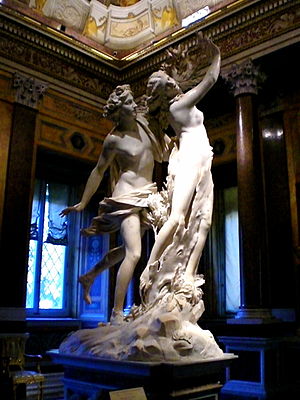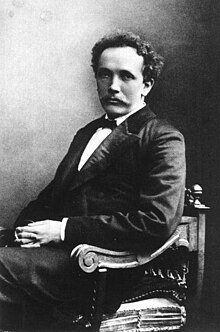Daphne (/ˈdæfniË/; Greek: Î"άφνη, meaning "laurel") is a minor figure in Greek mythology known as a naiadâ€"a type of female nymph associated with fountains, wells, springs, streams, brooks and other bodies of freshwater. There are several versions of the myth, but the general narrative is that because of her beauty, Daphne attracted the attention and ardor of the god Apollo (Phoebus). Apollo pursued her and just before being overtaken, Daphne pleaded to her father, the rivergod Ladon, and Ge (Gaia) for help. So Ladon then transformed Daphne into a laurel tree. In Metamorphoses by Roman poet Ovid, she is identified as the daughter of the rivergod Pineios in Thessaly. At the Pythian Games which were held every four years in Delphi in honour of Apollo, a wreath of laurel gathered from the Vale of Tempe in Thessaly was given as a prize. According to Pausanias the reason for this "simply and solely because the prevailing tradition has it that Apollo fell in love with the daughter of Ladon (Daphne)".
The story of Daphne in mythology

According to Greek myth, Apollo chased the nymph Daphne, daughter either of Peneus and Creusa in Thessaly, or of the river Ladon in Arcadia. The pursuit of a local nymph by an Olympian god, part of the archaic adjustment of religious cult in Greece, was given an arch anecdotal turn in Ovid's Metamorphoses, where the god's infatuation was caused by an arrow from Eros, who wanted to make Apollo pay for making fun of his archery skills and to demonstrate the power of love's arrow. Ovid treats the encounter, Apollo's lapse of majesty, in the mode of elegiac lovers, and expands the pursuit into a series of speeches. According to the rendering Daphne prays for help either to the river god Peneus or to Gaia, and is transformed into a laurel (Laurus nobilis): "a heavy numbness seized her limbs, thin bark closed over her breasts, her hair turned into leaves, her arms into branches, her feet so swift a moment ago stuck fast in slow-growing roots, her face was lost in the canopy. Only her shining beauty was left." "Why should she wish to escape? Because she is Artemis Daphnaia, the god's sister," observed the Freudian anthropologist Géza Róheim, and Joseph Fontenrose concurs; boldly stating such a one-to-one identity doubtless oversimplifies the picture: "the equation of Artemis and Daphne in the transformation myth itself clearly cannot work", The laurel became sacred to Apollo, and crowned the victors at the Pythian Games. Most artistic impressions of the myth focus on the moment of transformation.
A version of the attempt on Daphne's sworn virginity that has been less familiar since the Renaissance was narrated by the Hellenistic poet Parthenius, in his Erotica Pathemata, "The Sorrows of Love". Parthenius' tale, based on the Hellenistic historian Phylarchus, was known to Pausanias, who recounted it in his Description of Greece (2nd century CE). In this, which is the earliest written account, Daphne is a mortal girl fond of hunting and determined to remain a virgin; she is pursued by the lad Leucippos ("white stallion"), who assumes girl's outfits in order to join her band of huntresses. He is so successful in gaining her innocent affection, that Apollo is jealous and puts it into the girl's mind to stop to bathe in the river Ladon; there, as all strip naked, the ruse is revealed, as in the myth of Callisto, and the huntresses plunge their spears into Leucippos. At this moment Apollo's attention becomes engaged, and he begins his own pursuit; Parthenius' modern editor remarks on the rather awkward transition, linking two narratives.
While the story of Daphne is traditionally connected with the bay laurel (Laurus nobilis), almost 90 species of evergreen shrubs noted for their scented flowers and poisonous berries are grouped under the genus Daphneâ€"including the garland flower (Daphne cneorum); the February Daphne or mezereon (Daphne mezereum); and spurge laurel or wood laurel (Daphne laureola). These genera are categorized in the family Thymelaeaceae and are native to Asia, Europe and North Africa.
Temples dedicated to Daphne

Artemis Daphnaia
Artemis Daphnaia, who had her temple among the Lacedemonians, at a place called Hypsoi in Antiquity, on the slopes of Mount Cnacadion near the Spartan frontier, had her own sacred laurel trees.
Temple of Apollo Daphnephoros, Eretria
At Eretria the identity of an excavated 7th- and 6th-century BCE temple to Apollo Daphnephoros, "Apollo, laurel-bearer", or "carrying off Daphne", a "place where the citizens are to take the oath", is identified in inscriptions.
The myth depicted in later works

- La Dafne (1594), opera by Marco da Gagliano to a libretto Ottavio Rinuccini
- Dafne (1598), opera by Jacopo Peri and Jacopo Corsi to a libretto by Ottavio Rinuccini
- Die Dafne (1627), lost opera by Heinrich Schütz to a libretto by Martin Opitz, a translation of Rinuccini's libretto
- Daphne (1938), opera by Richard Strauss about the legend based on accounts by both Ovid and Euripides
A famous rendition of the subject is Gian Lorenzo Bernini's sculpture Apollo and Daphne. In Apotheon, a computer game by Alientrap, Daphne remains hidden in Apollo's garden, where he replanted her for his perverse enjoyment. The player eventually frees her from her captivity.
- Daphne's transformation in art
Notes
.jpg/220px-Daphne_Blake_(SMG_02).jpg)
External links

- Theoi Project: Daphne
- Apollo and Daphne â€" statue by Gian Lorenzo Bernini
- The Warburg Institute Iconographic Database: ca 200 images of Apollo and Daphne
